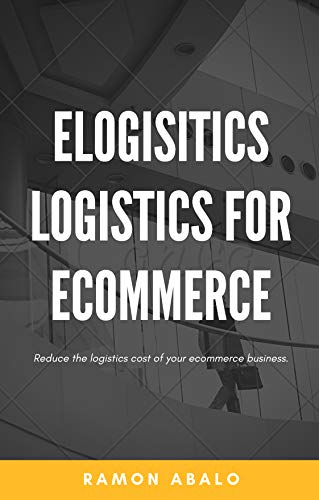eLogistics – Logistics for Ecommerce By Ramon Abalo Costa
Recommendation
E-commerce is moving toward a more direct model as the global marketplace connects increasingly through technology, and customers demand more from vendors. Technologies such as blockchain will disrupt the global marketplace further, changing the way buyers, sellers and intermediaries engage. Whether you’re navigating the logistics of choosing the right warehouse or selecting the best sales platform, you’ll find that e-commerce executive Ramon Abalo Costa demystifies the process for you in this detailed, step-by-step guide.
Take-Aways
- Consider supply and shipping chain integration when you choose a sales platform.
- Avoid shipping errors and keep workers safe by adopting best practices.
- Consider all cost factors when designing your order fulfillment procedures.
- Opening more than one warehouse may be a competitive strategy.
- Boost efficiency and reduce costs by choosing the right warehouse.
- Satisfy customer demand while remaining efficient and competitive as you ship and export goods.
- Reduce product returns to avoid burdening your company financially.
- Understand your customers, and optimize their online shopping experience.
eLogistics Book Summary
Consider supply and shipping chain integration when you choose a sales platform.
Companies that conduct business through e-commerce generally center that function around a sales portal or website. You can use one of these popular e-commerce platforms:
- Magento – This platform integrates with most international shipping and domestic carriers and provides a large list of supply-chain integrations.
- Shopify – This platform offers integration options with major US-based shipping companies plus some limited international shipping options. Shopify provides less sophisticated supply-chain integration offerings than Magento.
- WooCommerce (WordPress) – Roughly 30% of websites use WordPress’s platform. WooCommerce offers plug-in options for shipping carriers worldwide along with basic supply-chain integration options.
- BigCommerce – This platform has US-based default shipping carriers and you can add global carriers through its app store. BigCommerce doesn’t have as many supply-chain integration options as Magento, but offers more sophisticated integration options than Shopify.
- eBay – Shipping carriers provide eBay users with preferential rates, but the platform offers only three carrier options. You can integrate an eBay store with supply-chain management software and with systems such as CRM and ERP.
- Amazon – Use Amazon’s fulfillment center or choose from an extensive list of carriers to fulfill your orders. Amazon’s “Supply Chain Connect” management system provides integration among your Amazon store, your supply chain and other e-commerce platforms.
Consider the impact of the preferred payment methods in any region you enter. For example, in India, Eastern Europe, the Middle East and Indonesia, cash on demand (COD) payments are popular. However, COD payments correlate with an increase in order cancellations, missed deliveries and abandoned carts. Other factors that increase the rate of online cart abandonment include extra checkout costs and slow shipping times.
“Nowadays, a teenager in Morocco can source goods from a company in China, and sell the products to companies in the US and Europe within a few hours for less than $100.”
Offer customers multiple shipping options, including various ways to collect orders at collection points; flat-rate shipping for products of similar size and weight; free shipping, if you build the costs into your margins; express options; and options to self-select the date and time they will receive goods. Be transparent about shipping time frames, methods and rates, as well as potential duties and taxes that customers might face in different regions.
Avoid shipping errors and keep workers safe by adopting best practices.
Best practices include separate receiving and dispatching spaces to avoid cross-contamination of goods. When you’re managing inventory, inspect incoming shipments to avoid errors. Check the quality and number of goods in your receiving area. Provide adequate safety training, resources, protective wear and safety equipment for your staff. Keep your warehouses clean. Post standard operating procedures in visible locations throughout, and stock warehouses with first aid kits. Avoid manual lifting by providing pallet jacks and trolleys to prevent accidents.
“Receiving goods is an important process in any warehouse. This is essentially the transfer of ownership and responsibility, between the logistics company (or supplier) and the receiving party (or buyer).” ”
Whether your business is large or small, create an effective system for purchase ordering. This will help you maintain strong relationships with your suppliers, minimize fulfillment delays, boost profits, and manage cash flow and inventory effectively. Enterprise Resource Planning (ERP) software applications such as Oracle and SAP can help you implement such a system.
As your business grows, designate responsibility for both monitoring inventory and handling purchasing to a single person. Familiarize yourself with the International Chamber of Commerce’s “Incoterms” (ICCs) – standardized terms that specify which parties pay for shipping and taxes. For example, if your Incoterm is “Delivered at Place” (DAP), your company is responsible for the goods you sell until they reach their destination – excluding taxes and duties, which the buyer pays. E-commerce sites must deal with returns: Customers return items to retail e-commerce sites 20% of the time. Create a clear returns policy, specifying the terms and conditions under which you’ll provide refunds and a time frame for accepting returned goods.
Consider all cost factors when designing your order fulfillment procedures.
The design of your order fulfillment process depends on your company’s size and offerings. Generally, organizations follow these steps in the fulfillment process: Confirm the order, locate the product, send it to packaging, package the order, ship the product, deliver the product and manage returns. Choose among three types of order fulfillment: in-house, third-party (using a platform like Amazon) or dropshipping. The last type, dropshipping, differs from using a third-party platform in that the wholesaler absorbs all the risks of storing and owning inventory. Unfortunately, dropshipping often includes providing customer data to the wholesaler, who could, theoretically, steal your customers with competitive pricing.
Consider costs when deciding whether to fulfill orders in-house or to outsource fulfillment through third-party platforms or dropshipping. Real estate, warehouse prices, technology and labor all affect costs. For small businesses, in-house fulfillment is often the cheapest and provides the added benefit of letting you retain power over your brand’s image. If you fulfill a high volume of orders, in-house handling can be more affordable and beneficial, since you control corporate and customer data.
“The internet has opened us to a global market. You can be anywhere in the world and sell just about anything to someone else on the opposite side of the globe.”
You may want to hire a third-party logistics provider (3PL) – a company that manages order fulfillment for merchants – if you find that:
- Order fulfillment requires more than an hour per day of someone’s workday.
- You lack the space to fulfill orders.
- You can predict seasonal spikes in sales, which can contribute to declining quality control as you hire temporary staff.
Vet your 3PL. Make sure it is a reputable company. A four-party logistics provider can combine your logistics and fulfillment services in a single point of contact.
Opening more than one warehouse may be a competitive strategy.
Many incorrectly assume the United States has the biggest global e-commerce market. In fact, China’s is the largest, due to its growing middle class and high demand for Western brands.
You may decide to invest in more than one warehouse around the world if you have a high volume of orders, you ship large or heavy items globally, and you want to maintain a competitive edge and provide fast delivery. Many of today’s consumers expect to receive their goods in one or two days.
“If opening a second fulfillment center will increase sales but reduce profits, then perhaps you need to come up with a better strategy.”
Offer more competitive pricing if you have fulfillment centers in the geographic region nearest your customers. That eliminates potential hassles from shipping goods across borders. Having more than one fulfillment location enables you to split your inventory regionally. People in different locations or climates have different consumer preferences.
Boost efficiency and reduce costs by choosing the right warehouse.
A “private” warehouse is one you own. Companies often lease public warehouses, particularly during high-demand seasons like Christmas when they need extra warehouse space for a short time. Those that sell perishable goods, such as food items, need climate-controlled warehouses. Companies that can afford a higher initial capital investment may use automated warehouses to improve safety, reduce the number of employees and fulfill orders more quickly. To fulfill orders, create systems for picking – locating goods and moving them to a packaging area – and packaging. Boost efficiency and improve safety by automating some steps of your order fulfillment process with automated vehicles and inventory management systems. As the relevant technologies become more affordable, 24-hour automation will dominate.
“The accepted industry standard [as] of 2019 is 24 to 48 hours for an e-commerce warehouse to fulfill an order.”
Consider your packing and packaging processes. Choose packing with the goal of reducing dimensional weight shipping costs. As the popularity of “unboxing” e-commerce goods on YouTube reveals, consumers connect with packaging. Customize a brand-specific customer experience. Select a local or cloud-based warehouse management system – some are basic, while others are complex and connect to multiple warehouses – to ensure quick, accurate warehouses operation.
Satisfy customer demands while remaining efficient and competitive as you ship and export goods.
Different courier services have different shipment methods. Domestic shipping options can include same-day delivery, one-day or next-business-day delivery, two-to-three-day delivery or standard shipping. In large countries, ground delivery (the cheapest option) can take weeks. An increasing number of e-commerce customers – one in four, according to a report from BI Intelligence – say they might not place orders without same-day delivery.
International shipping is more complex. You must navigate borders and customs. Your options include international express/priority shipping. This is the most expensive method, and takes one to three days. Shipping through international postal or Express Mail Service (EMS) takes 10 to 20 days. Direct injection is a growing e-commerce method: Sellers ship goods across borders, directly to customers. If you ship across national borders, research the relevant duties and taxes and the various international clearance methods – the most common being B2C clearance, which requires customers to pay duties or taxes before they receive the goods.
“Deciding which courier is right for your business is a choice you should not take lightly. In e-commerce, this might be the only physical interaction you have with your clients, so it’s imperative that you don’t make this decision solely on price.”1884”
Logistics companies’ biggest challenge is “last-mile delivery,” since that requires a courier to deliver parcels individually. Large courier services – such as FedEX, UPS and TNT – handle last-mile deliveries, as do specialized regional companies. You can cover last-mile delivery with community drop-off points or in-home delivery services – for example, giving Amazon couriers access to customers’ homes via smart locks. Crowdsourcing – using nonprofessional drivers to deliver goods in some areas – is another option. Consider environmentally friendly delivery options, such as bike couriers. Tools such as an API, app integration and real-time messaging updates can help you avoid missed deliveries, which can be costly. Omnichannel delivery – in which shippers integrate with local retailers’ stock system – helps reduce shipping costs.
Reduce product returns to avoid burdening your company financially.
Customers return items for a variety of reasons: You shipped an incorrect product or size; they ordered the wrong thing; they received a damaged or defective product; or they experienced dissatisfaction with the item. Or, they could be committing fraud, such as “wardrobing” – buying an item to wear only once and return. Other forms of fraud include customers ordering luxury goods that they swap for fake goods, which they then return to you. Couriers may return undelivered shipments due to missed deliveries, incorrect address information or payment disputes.
“Returns come with a big financial burden for e-commerce stores, so it’s crucial to ensure that your company is set up to handle this part of the business correctly.”
Reduce the financial burden of returns by avoiding marketplaces that embrace unfriendly seller policies, such as returns after 30 days. Share detailed product descriptions, clear shipping guidelines and your unique return policy with your customers. Inspect returns, and use only trustworthy suppliers. Stop selling products that have high return rates. Respond to customer reviews. Take advantage of reporting systems that require customers to share their reasons for returning goods, and leverage that information to avoid returns in the future.
Familiarize yourself with the varying returns regulations in different countries. Find an effective logistics partner to handle returns – ideally, one who can integrate into your systems and offer services such as shipment consolidation and tracking and reporting data.
Understand your customers, and optimize their online shopping experience.
To generate revenue and profit, e-commerce stores must retain repeat customers. Designate workers to answer your shoppers’ messages and engage them online. Let customers write reviews, take surveys or rate your products. Consider outsourcing the customer-contact function to a 24-hour call center and offering customers convenient services, such as home delivery and express checkout. To retain your staff, create a positive company culture that promotes employee pride and happiness. Technologies such as blockchain will shape the future of e-logistics. Blockchain provides standardized technologies that bolster trust among sellers, buyers and intermediaries by ensuring the security, transparency and traceability of transactions.
“Smart contracts will have a fundamental impact on banks and letters of credit.”
Blockchain is introducing integrated digital contracts, or “Smart Contracts,” which boost the efficiency of transactions. This works by linking contracts to entire supply-chain systems through digitizing documents – such as letters of credit – while protecting against fraud and intellectual property theft.
About the Author
Abalo Costa is the general manager, Asia-Pacific, for APG eCommerce Solutions. He writes a blog about e-commerce logistics.


